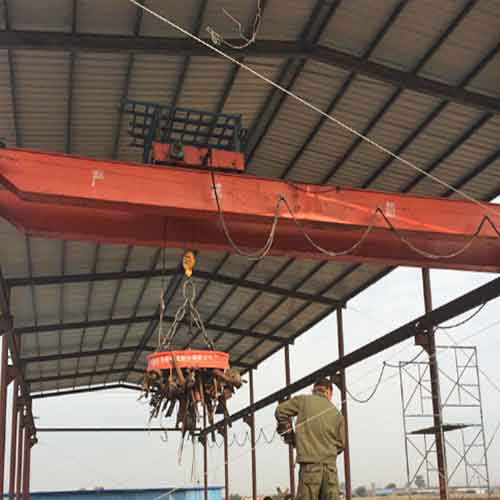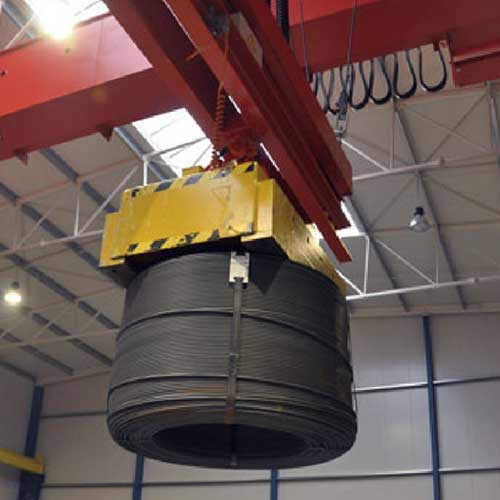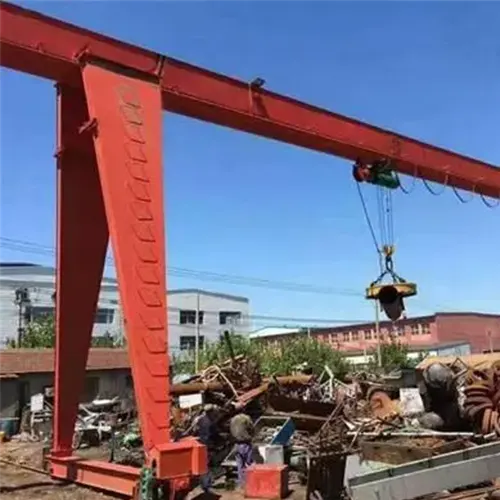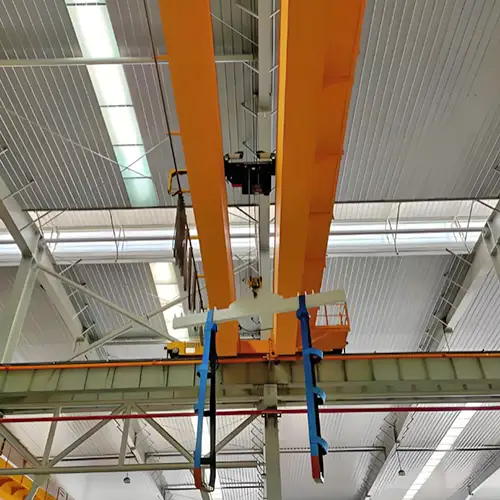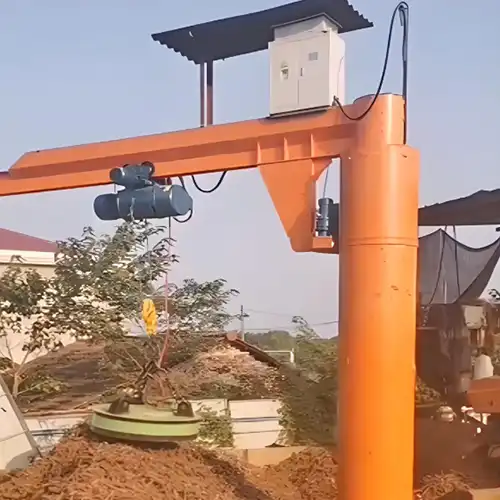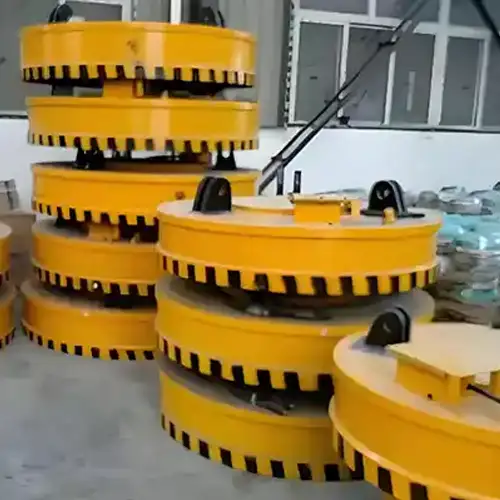How to Operate Electromagnetic Overhead Crane during Power Failures?
Safe operation of electromagnetic overhead cranes during power failures, ensuring magnet retention to securely hold loads until power is restored. Click!
Category: Magnetic Crane
Your Trusted Electromagnetic Overhead Crane Manufacturer & Supplier
How to Operate Electromagnetic Overhead Crane During Power Failures?
Ensuring Safety During Power Failures for Electromagnetic Overhead Cranes
Safe operation of electromagnetic overhead cranes during power failures, ensuring magnet retention to securely hold loads until power is restored. Click!
In industries where precision and efficiency are paramount, the smooth operation of electromagnetic overhead cranes is essential. However, even the most reliable systems can encounter unexpected challenges, such as power failures. When these occur, ensuring the safety of both personnel and equipment becomes the top priority. In this blog, we'll delve into the importance of safety protocols during power outages for electromagnetic overhead cranes and outline key steps to minimize risks effectively.
Power failures can happen for various reasons, from grid issues to equipment malfunctions, and their impact on crane operations can be significant. Without power, cranes may lose their ability to move loads safely, potentially leading to accidents, injuries, or damage to materials and infrastructure. Recognizing this risk underscores the critical need for robust safety measures.
To address these concerns, let's explore the key steps that industries can implement to safeguard against the adverse effects of power failures on electromagnetic overhead cranes:
- Emergency Procedures: Establishing clear emergency procedures ensures that all personnel are well-prepared to respond swiftly and effectively in the event of a power failure. Training operators on these protocols is crucial to minimize downtime and mitigate potential risks.
- Emergency Power Backup: Installing emergency power backup systems, such as uninterruptible power supply (UPS) units or generators, provides a reliable source of electricity during outages. These backup systems enable cranes to maintain essential functions, allowing for controlled shutdowns or continued operation until normal power is restored.
- Securing the Load: In the event of a power failure while lifting or moving a load, immediate action must be taken to secure it safely. Lowering the load to the ground or a stable position using manual controls helps prevent accidents and minimizes the risk of damage to materials or equipment.
- Activating Emergency Stop: Engaging the emergency stop function halts all crane movements instantly, preventing any unexpected motion during a power outage. This critical safety feature protects personnel and equipment from potential harm and allows for a controlled response to the situation.
- Assessing the Situation: Conducting a thorough assessment of the power failure's cause and impact is essential for determining the appropriate course of action. Understanding the extent of the outage and any associated risks enables informed decision-making to mitigate further complications.
By implementing these measures and emphasizing the importance of safety protocols during power failures, industries can minimize the potential risks and disruptions to electromagnetic overhead crane operations. Prioritizing safety not only protects personnel and equipment but also contributes to maintaining efficiency and productivity in industrial settings.
Emergency Procedures
Importance of Clear Emergency Procedures
In the high-stakes environment of industrial operations involving electromagnetic overhead cranes, clear and concise emergency procedures are not just a nicety but a necessity. These protocols serve as the guiding light when the unexpected strikes, ensuring that every member of the team knows precisely what to do to safeguard lives, equipment, and productivity.
During a power failure or any other unforeseen event, chaos can quickly ensue if there are no established procedures in place. Without clear instructions, confusion reigns, and valuable time is lost as personnel scramble to figure out the best course of action. This delay can exacerbate the situation, leading to increased risks of accidents, injuries, or damage to property.
Clear emergency procedures provide a roadmap for swift and decisive action. They outline the steps to be taken, assign responsibilities, and establish communication channels to coordinate the response effectively. Whether it's activating emergency stop controls, securing loads, or evacuating the area, these procedures leave no room for ambiguity, ensuring that everyone knows their role in mitigating the crisis.
Moreover, well-defined emergency procedures foster a culture of preparedness and accountability within the organization. By emphasizing the importance of safety and proactive planning, they empower employees to respond calmly and confidently in the face of adversity. This proactive approach not only enhances workplace safety but also instills trust and confidence among team members, bolstering morale and cohesion.
Training for Operators on Emergency Protocols
Equally vital to the existence of clear emergency procedures is the comprehensive training of operators on these protocols. After all, a plan is only as good as its execution, and without proper training, even the best-laid procedures may falter in practice.
Operators serve as the frontline responders during emergencies, tasked with implementing the prescribed actions to mitigate risks and ensure safety. As such, they must be equipped with the knowledge, skills, and confidence to navigate challenging situations effectively.
Training for operators on emergency protocols should encompass various aspects, including:
- Familiarization with Procedures: Operators should be thoroughly acquainted with the emergency procedures specific to electromagnetic overhead cranes. This includes understanding the sequence of steps to be followed, the location and operation of emergency controls, and protocols for communication and coordination with other personnel.
- Simulation Exercises: Practical training through simulation exercises allows operators to experience simulated emergency scenarios in a controlled environment. These drills provide valuable hands-on experience, allowing operators to practice their response strategies and identify areas for improvement.
- Risk Awareness: Training should also focus on developing risk awareness among operators, helping them recognize potential hazards and anticipate challenges that may arise during emergencies. By understanding the risks associated with different scenarios, operators can make informed decisions and take proactive measures to mitigate them.
- Communication Skills: Effective communication is essential during emergencies, both within the crane operator team and with other stakeholders. Training should emphasize the importance of clear and concise communication, ensuring that operators can convey critical information accurately and efficiently under pressure.
- Continuous Education: Emergency response protocols may evolve over time in response to feedback, lessons learned, or changes in regulations. Therefore, ongoing education and refresher training are essential to keep operators up-to-date with the latest procedures and best practices.
By investing in comprehensive training for operators on emergency protocols, organizations can enhance their readiness to respond to power failures and other emergencies effectively. This proactive approach not only protects personnel and assets but also reinforces a culture of safety and resilience throughout the organization.
Emergency Power Backup
Types of Emergency Power Backup Systems
When power failures occur in industrial settings involving electromagnetic overhead cranes, having reliable backup power systems in place is crucial to maintaining operations and ensuring safety. Two common types of emergency power backup systems are uninterruptible power supply (UPS) units and generators.
- Uninterruptible Power Supply (UPS): UPS units provide short-term backup power during brief outages or fluctuations in electrical supply. They typically consist of batteries that are continuously charged when mains power is available. In the event of a power failure, the UPS automatically switches to battery power, providing immediate support to critical equipment such as control panels and emergency lighting. UPS systems are ideal for protecting sensitive electronic equipment from power surges and voltage fluctuations.
- Generators: Generators offer a more robust solution for prolonged power outages. These standalone power sources are capable of producing electricity independently of the grid, utilizing fuel (such as diesel or natural gas) to generate power. Generators come in various sizes and configurations, from portable units suitable for smaller applications to large stationary units designed to support entire facilities. During a power failure, generators automatically kick in to supply electricity to essential systems, including electromagnetic overhead cranes, ensuring uninterrupted operation until normal power is restored.
Role of Backup Power in Maintaining Crane Safety During Outages
The role of backup power in maintaining crane safety during outages cannot be overstated. Electromagnetic overhead cranes play a critical role in lifting and moving heavy loads within industrial facilities, and any interruption in their operation can pose significant safety risks. Backup power systems mitigate these risks by providing a reliable source of electricity to keep cranes operational during power failures, thereby ensuring the continued safety of personnel and assets.
- Continuity of Operations: Backup power systems enable electromagnetic overhead cranes to remain operational even when mains power is unavailable. This continuity of operations minimizes disruptions to workflow and prevents costly downtime associated with halted crane operations.
- Safe Load Handling: During a power failure, cranes may be in the process of lifting or moving heavy loads. Without backup power, these loads could become unstable, leading to accidents, injuries, or damage to materials and equipment. Backup power systems ensure that cranes can safely complete their lifting and maneuvering tasks, reducing the risk of incidents during outages.
- Emergency Response: In emergency situations where prompt action is required, backup power systems provide the necessary electricity to operate critical systems, including cranes. Whether it's evacuating personnel or addressing safety hazards, having functional cranes powered by backup systems enhances the facility's emergency response capabilities.
- Preventative Maintenance: Backup power systems also support ongoing maintenance activities for electromagnetic overhead cranes. By ensuring that cranes remain powered during scheduled maintenance or inspections, backup power systems facilitate proactive upkeep and help prevent equipment failures or malfunctions.
In summary, emergency power backup systems, such as UPS units and generators, play a vital role in maintaining crane safety during power outages. By providing uninterrupted electricity to electromagnetic overhead cranes, these systems ensure the continued functionality of critical equipment, safeguarding personnel and assets in industrial environments. Investing in reliable backup power solutions is therefore essential for enhancing safety and resilience in the face of unforeseen power disruptions.
Secure the Load
In the event of a power failure during the operation of electromagnetic overhead cranes, securing the load becomes paramount to prevent accidents, injuries, and damage to materials or equipment. Let's explore the immediate actions to secure a load and the utilization of manual controls for lowering loads to a safe position.
Immediate Actions to Secure a Load During a Power Failure
When a power failure occurs while a load is suspended or in motion, swift and decisive action is necessary to prevent any potential hazards. The following immediate actions should be taken to secure the load effectively:
- Activate Emergency Stop: The crane operator should immediately activate the emergency stop function to halt all crane movements. This action prevents any further motion of the crane and the load, minimizing the risk of accidents or injuries.
- Assess the Situation: The operator and other personnel in the vicinity should assess the situation carefully. They should determine the status of the load, including its weight, position, and stability, to gauge the appropriate course of action.
- Communicate with Team Members: Clear communication is essential during emergencies. The operator should communicate with other team members to inform them of the power failure and coordinate efforts to secure the load safely.
- Implement Secondary Restraints: If available, secondary restraints such as chains, straps, or clamps should be used to secure the load in its current position. These additional measures help prevent the load from shifting or falling unexpectedly.
- Evacuate the Area if Necessary: If the situation poses an imminent risk to personnel or property, evacuation of the area may be necessary. Personnel should follow established evacuation procedures to move to a safe location until the situation is resolved.
Use of Manual Controls for Lowering Loads to a Safe Position
In cases where the load needs to be lowered to a safe position following a power failure, manual controls offer a reliable solution. The utilization of manual controls allows operators to maintain control over the crane and safely lower the load to the ground or a stable surface. Here's how manual controls are typically employed:
- Locate Manual Control Panel: Most electromagnetic overhead cranes are equipped with manual control panels located near the crane or at a centralized control station. Operators should locate the manual control panel and familiarize themselves with its operation.
- Activate Manual Mode: The operator switches the crane to manual mode, bypassing the automated controls affected by the power failure. This action enables the operator to control the crane's movements manually using the control panel.
- Lower the Load Safely: Using the manual controls, the operator carefully lowers the load to the ground or a designated safe position. The operator must exercise caution and precision to ensure a controlled descent, avoiding sudden movements that could endanger personnel or equipment.
- Monitor Load Position: Throughout the lowering process, the operator should monitor the position of the load closely. Adjustments may be necessary to ensure that the load reaches the desired location safely and without incident.
- Return to Normal Operations: Once the load has been safely lowered and secured, the operator can return the crane to normal operations once power is restored. It is essential to conduct thorough checks and inspections to verify that the equipment is in proper working condition before resuming regular operations.
By following these immediate actions and utilizing manual controls effectively, operators can secure loads and mitigate risks during power failures involving electromagnetic overhead cranes. Prioritizing safety protocols and training ensures that personnel are equipped to respond to emergencies swiftly and effectively, minimizing the potential for accidents or damage.
How Can Electromagnetic Overhead Cranes be Safely Managed During Power Failures?
Safe Operation of Electromagnetic Overhead Crane Power Failure Magnet Retention Operation
Activate Emergency Stop
In the event of a power failure or any other emergency situation involving electromagnetic overhead cranes, activating the emergency stop function is critical to ensuring the safety of personnel and preventing accidents or damage. Let's explore the purpose of the emergency stop function on cranes and the importance of engaging it during power outages.
Purpose of Emergency Stop Function on Cranes
The emergency stop function, also known as the emergency stop button or E-stop, is a safety feature designed to immediately halt all crane movements in case of an emergency. Its primary purpose is to bring the crane to a rapid and controlled stop to prevent accidents, injuries, or damage to materials or equipment. Here's why the emergency stop function is essential:
- Immediate Response: The emergency stop function provides a quick and decisive means of stopping crane operations in emergencies. With a single press of the button, all crane movements, including lifting, lowering, and traversing, are halted instantly.
- Safety of Personnel: The primary concern during emergencies is the safety of personnel working in the vicinity of the crane. By stopping all crane movements promptly, the emergency stop function helps prevent accidents or injuries caused by moving loads or swinging crane components.
- Protection of Equipment: In addition to safeguarding personnel, the emergency stop function helps protect equipment and materials from damage. By halting crane operations immediately, it reduces the risk of collisions, overloads, or other mechanical failures that could result in costly repairs or downtime.
- Emergency Situations: The emergency stop function is invaluable in various emergency scenarios, including power failures, equipment malfunctions, or the presence of hazards in the crane's path. It provides operators with a reliable means of responding to unforeseen circumstances quickly and effectively.
Importance of Engaging Emergency Stop During Power Outages
During power outages, engaging the emergency stop function becomes even more critical due to the loss of control over crane operations. Here's why it's essential to activate the emergency stop during power outages:
- Prevention of Uncontrolled Movement: Power failures can cause electromagnetic overhead cranes to lose power suddenly, resulting in uncontrolled movements of loads or crane components. Engaging the emergency stop function immediately upon detecting a power outage helps prevent these uncontrolled movements, minimizing the risk of accidents or damage.
- Maintaining Safety: With the loss of power, the crane operator may no longer have the ability to control crane movements using conventional means. Engaging the emergency stop function ensures that all crane operations are brought to a swift and controlled stop, prioritizing the safety of personnel and equipment.
- Preventing Damage: Power outages can create hazardous conditions for crane operations, increasing the risk of collisions, falls, or other accidents. By activating the emergency stop, operators prevent potential damage to materials, equipment, and infrastructure, minimizing the financial and operational impact of the outage.
- Facilitating Recovery: Engaging the emergency stop function during a power outage facilitates the recovery and restoration process. It allows maintenance personnel to assess the situation safely, conduct necessary repairs, and prepare for the resumption of crane operations once power is restored.
In summary, the emergency stop function on electromagnetic overhead cranes serves as a crucial safety feature for preventing accidents and protecting personnel and equipment in emergencies. During power outages, engaging the emergency stop becomes even more vital, as it helps maintain control over crane operations and mitigate the risks associated with sudden loss of power. By prioritizing safety and ensuring operators are trained to respond effectively to emergencies, organizations can minimize the impact of power outages on crane operations and maintain a safe working environment.
Assess the Situation
In the event of a power failure affecting electromagnetic overhead cranes, conducting a thorough assessment of the situation is crucial to determine the cause, extent, and potential risks associated with the outage. Let's explore the steps involved in assessing the situation and evaluating the risks and potential damage to equipment.
Steps to Assess the Cause and Extent of a Power Failure
- Initial Observation: Upon detecting a power failure, crane operators and other personnel should immediately observe and verify the loss of power. This includes checking for any indicators such as lights or alarms that signal a power outage.
- Check Electrical Systems: Inspect the electrical systems associated with the crane, including control panels, power supply connections, and circuit breakers. Look for any visible signs of damage, overheating, or tripped breakers that may indicate the cause of the power failure.
- Communication: Communicate with maintenance personnel or utility providers to gather information about the status of the power supply. Determine if the outage is localized to the facility or part of a broader grid failure affecting multiple areas.
- Investigate Potential Causes: Identify potential causes of the power failure, such as equipment malfunctions, electrical faults, external factors like storms or natural disasters, or utility-related issues. Consider historical data or past incidents that may provide insights into recurring issues.
- Assess Impact: Evaluate the impact of the power failure on crane operations, production schedules, and safety. Determine the criticality of the affected equipment and prioritize actions accordingly.
- Record Information: Document observations, findings, and any relevant details about the power failure, including timestamps, environmental conditions, and personnel involved. This information can aid in troubleshooting, reporting, and implementing corrective measures.
Evaluation of Risks and Potential Damage to Equipment
- Assess Equipment Status: Conduct a visual inspection of the electromagnetic overhead cranes and associated equipment to assess their condition following the power failure. Look for any signs of damage, wear, or abnormalities that may have occurred during the outage.
- Check Load Stability: Verify the stability of any loads suspended by the crane at the time of the power failure. Assess whether the loads are securely positioned and whether any adjustments or additional restraints are necessary to prevent accidents or damage.
- Evaluate Environmental Factors: Consider environmental factors such as temperature, humidity, and exposure to contaminants that may affect the integrity of the equipment. Assess whether any environmental conditions pose additional risks to equipment operation or safety.
- Identify Potential Hazards: Identify potential hazards or safety risks associated with the power failure, such as obstructed pathways, unsecured materials, or compromised structural integrity. Take measures to mitigate these risks and ensure a safe working environment.
- Consult Maintenance Guidelines: Refer to manufacturer guidelines or maintenance manuals for specific recommendations on assessing equipment condition following a power failure. Follow prescribed procedures for inspecting, testing, and restoring equipment to operational status.
- Prioritize Repairs: Based on the assessment findings, prioritize repairs, maintenance, or replacement of equipment components as needed to restore functionality and ensure safety. Address any critical issues promptly to minimize downtime and mitigate risks of further damage.
By following these steps to assess the cause and extent of a power failure and evaluating risks and potential damage to equipment, organizations can effectively manage the aftermath of outages and ensure the safety and reliability of electromagnetic overhead cranes. Maintaining a proactive approach to equipment maintenance and safety protocols is essential for minimizing disruptions and protecting personnel and assets in industrial environments.
Communicate
Effective communication is paramount during power outages affecting electromagnetic overhead cranes. Clear and timely communication with relevant personnel ensures coordinated actions and updates to mitigate risks and minimize disruptions. Let's delve into the importance of clear communication and the coordination of actions during power outages.
Importance of Clear Communication with Relevant Personnel
- Safety: Clear communication is essential for ensuring the safety of personnel working in the vicinity of electromagnetic overhead cranes during power outages. By providing timely information about the situation and any necessary precautions, personnel can take appropriate measures to protect themselves from potential hazards.
- Risk Mitigation: Effective communication helps identify and mitigate risks associated with power outages. By sharing information about the cause and extent of the outage, as well as any potential impacts on crane operations or facility safety, personnel can proactively address risks and implement preventive measures.
- Task Allocation: Clear communication enables the assignment of tasks and responsibilities to relevant personnel. By delineating roles and expectations during power outages, teams can work together efficiently to address critical issues, such as securing loads, assessing equipment status, or implementing emergency procedures.
- Problem-Solving: During power outages, unforeseen challenges or obstacles may arise that require collaborative problem-solving. Clear communication fosters open dialogue and idea-sharing among team members, facilitating the identification of solutions and the implementation of effective countermeasures.
- Maintaining Morale: Transparent communication fosters trust and confidence among personnel, even in challenging situations. By keeping employees informed about developments, updates, and contingency plans, organizations can maintain morale and cohesion, minimizing uncertainty and anxiety.
Coordination of Actions and Updates During Power Outages
- Establish Communication Channels: Designate primary communication channels, such as two-way radios, intercom systems, or messaging platforms, for disseminating updates and instructions during power outages. Ensure that all relevant personnel have access to these channels and are familiar with their use.
- Provide Regular Updates: Keep personnel informed about the status of the power outage, including any developments, estimated duration, and potential impacts on operations. Provide regular updates as new information becomes available to maintain situational awareness and keep everyone informed.
- Coordinate Response Efforts: Coordinate actions and response efforts among different teams and departments involved in managing the power outage. Establish clear lines of communication for sharing information, coordinating tasks, and requesting assistance as needed to address critical issues promptly.
- Monitor Progress: Continuously monitor progress in addressing the power outage and its impacts on crane operations and facility safety. Keep personnel updated on any changes or developments, and adjust response efforts accordingly to ensure an effective and coordinated response.
- Review and Learn: After the power outage has been resolved, conduct a post-incident review to evaluate the effectiveness of communication and response efforts. Identify any areas for improvement and implement corrective actions to enhance future response capabilities.
By prioritizing clear communication and coordination of actions during power outages affecting electromagnetic overhead cranes, organizations can minimize risks, maintain safety, and facilitate a swift and effective response. Investing in robust communication protocols and fostering a culture of transparency and collaboration ensures that personnel are well-equipped to manage emergencies and mitigate disruptions in industrial environments.
Follow Manufacturer Guidelines
Adhering to manufacturer recommendations is paramount when dealing with electromagnetic overhead cranes, especially during power failures. Let's explore the importance of following manufacturer recommendations and specific guidelines for handling power failures for different crane models.
Importance of Following Manufacturer Recommendations
- Safety Assurance: Manufacturers design electromagnetic overhead cranes with specific safety features and operational guidelines to ensure the safety of personnel and equipment. Following their recommendations helps maintain the integrity of these safety systems, reducing the risk of accidents or injuries during normal operations and emergencies.
- Optimal Performance: Manufacturers provide guidelines for the proper operation, maintenance, and troubleshooting of their crane models. By following these recommendations, organizations can optimize crane performance, minimize wear and tear, and extend the lifespan of the equipment.
- Compliance with Regulations: Manufacturers often design their crane models to meet industry standards and regulatory requirements. Adhering to manufacturer recommendations ensures compliance with these standards, reducing the risk of fines, penalties, or legal liabilities associated with non-compliance.
- Warranty Coverage: Manufacturers may offer warranties or service agreements for their crane models, contingent upon adherence to specified operating and maintenance guidelines. Failure to follow these recommendations could void warranty coverage, resulting in additional costs for repairs or replacements.
- Risk Mitigation: Manufacturer recommendations may include specific instructions for mitigating risks associated with common hazards, such as power failures, overloads, or equipment malfunctions. By following these guidelines, organizations can reduce the likelihood of accidents or damage to personnel and property.
Specific Guidelines for Handling Power Failures for Different Crane Models
- Emergency Procedures: Manufacturers typically provide detailed instructions for handling power failures or other emergencies affecting their crane models. These guidelines may include steps for activating emergency stop controls, securing loads, and implementing contingency measures to ensure safety during outages.
- Backup Power Systems: Manufacturers may recommend specific types of backup power systems, such as UPS units or generators, suitable for powering their crane models during power failures. Guidelines for installing, testing, and maintaining these systems ensure reliable backup power supply and uninterrupted crane operations.
- Manual Operation: In the event of a power failure, manufacturers may provide instructions for manually operating crane functions using backup controls or manual override mechanisms. These guidelines outline the procedures for safely lowering loads, traversing, or performing other essential tasks without electrical power.
- Equipment Checks: Manufacturers may recommend routine inspections and maintenance procedures for checking the condition of critical components, such as electrical wiring, sensors, and mechanical parts, to ensure their reliability during power failures. Regular checks help identify potential issues early and prevent unexpected failures.
- Training Requirements: Manufacturers may specify training requirements for operators and maintenance personnel responsible for operating and maintaining their crane models. Training programs cover essential topics such as emergency procedures, equipment operation, and troubleshooting techniques to ensure competency and compliance with manufacturer recommendations.
By following manufacturer guidelines for handling power failures and adhering to specific recommendations for different crane models, organizations can enhance safety, optimize crane performance, and mitigate risks associated with electrical outages. Prioritizing adherence to these guidelines demonstrates a commitment to safety, compliance, and the reliable operation of electromagnetic overhead cranes in industrial environments.
Restore Power Safely
Restoring power safely after an outage is crucial to ensuring the continued operation of electromagnetic overhead cranes without compromising safety. Let's explore the procedures for safely restoring power and the verification checks required before resuming normal operations.
Procedures for Safely Restoring Power After an Outage
- Assess the Cause: Before attempting to restore power, it's essential to determine the cause of the outage. Conduct a thorough investigation to identify any equipment malfunctions, electrical faults, or external factors that may have contributed to the power failure.
- Isolate Faults: If the outage was caused by equipment faults or electrical issues, isolate the affected circuits or components to prevent further damage or hazards. Follow established procedures for isolating power sources, tripping breakers, or disconnecting equipment as necessary.
- Notify Personnel: Inform relevant personnel, including crane operators, maintenance technicians, and supervisors, about the planned power restoration activities. Provide clear instructions and safety precautions to ensure that everyone is aware of the risks and procedures involved.
- Restore Power Gradually: Gradually restore power to the affected circuits or equipment to avoid sudden surges or overloads. Follow a step-by-step process, starting with non-essential systems and gradually reintroducing power to critical equipment, including electromagnetic overhead cranes.
- Monitor Voltage and Current: Continuously monitor voltage and current levels during the power restoration process to detect any abnormalities or fluctuations. Use testing equipment such as multimeters or voltage detectors to ensure that electrical parameters remain within safe operating limits.
- Verify Grounding and Bonding: Confirm that proper grounding and bonding connections are established before energizing electrical circuits or equipment. Grounding ensures the safe dissipation of electrical charges, while bonding prevents voltage differentials between conductive surfaces.
- Perform System Checks: After power is restored, conduct system checks to verify proper operation of electrical components, control systems, and safety devices. Test each function of the electromagnetic overhead cranes, including lifting, lowering, traversing, and emergency stop controls, to ensure functionality.
Verification Checks Before Resuming Normal Operations
- Visual Inspection: Conduct a visual inspection of electrical panels, wiring, connectors, and other components to check for any signs of damage, overheating, or loose connections. Ensure that all components are securely mounted and properly aligned.
- Functional Testing: Perform functional tests on critical systems, including emergency stop controls, backup power systems, and safety interlocks, to verify their proper operation. Test each function of the electromagnetic overhead cranes under load conditions to ensure that they perform as expected.
- Load Testing: If feasible, perform load testing on the cranes to verify their capacity and stability under normal operating conditions. Test various load weights and configurations to ensure that the cranes can handle their intended workload safely.
- Documentation Review: Review documentation, including maintenance logs, inspection reports, and equipment manuals, to ensure that all required checks and procedures have been completed satisfactorily. Document any findings or observations for future reference and compliance purposes.
- Operator Training: Ensure that crane operators and maintenance personnel are adequately trained on the proper operation and maintenance procedures following power restoration. Provide refresher training as needed to reinforce safety protocols and best practices.
By following these procedures for safely restoring power after an outage and conducting verification checks before resuming normal operations, organizations can minimize risks and ensure the reliable operation of electromagnetic overhead cranes. Prioritizing safety, thoroughness, and compliance with established procedures is essential for maintaining a safe and efficient working environment in industrial settings.
Review and Improve
After experiencing a power failure involving electromagnetic overhead cranes, conducting a post-incident review is crucial for identifying areas for improvement and implementing changes to prevent future incidents. Let's explore the importance of post-incident review and the process of identifying areas for improvement and implementing changes.
Importance of Post-Incident Review
- Learning Opportunity: A post-incident review provides a valuable learning opportunity for the organization. By analyzing the events leading up to and during the power failure, personnel can gain insights into what went wrong and how similar incidents can be prevented in the future.
- Root Cause Analysis: Conducting a thorough post-incident review allows the organization to identify the root causes of the power failure. This involves examining factors such as equipment malfunctions, human error, procedural failures, or external influences that contributed to the incident.
- Risk Mitigation: Understanding the root causes of the power failure enables the organization to develop strategies for mitigating similar risks in the future. By addressing underlying issues and implementing preventive measures, the organization can reduce the likelihood of recurrence and improve overall safety.
- Compliance and Accountability: Post-incident reviews help ensure compliance with regulatory requirements and internal policies. By documenting the incident and its findings, the organization demonstrates a commitment to accountability and transparency in addressing safety concerns.
- Continuous Improvement: Post-incident reviews are essential for fostering a culture of continuous improvement within the organization. By learning from past mistakes and implementing corrective actions, the organization can enhance its processes, procedures, and safety protocols over time.
Identification of Areas for Improvement and Implementation of Changes
- Gather Information: Collect data, reports, and documentation related to the power failure, including incident reports, maintenance records, and operator logs. Interview personnel involved in the incident to gather firsthand accounts and insights.
- Conduct Analysis: Analyze the collected information to identify contributing factors, root causes, and any systemic issues that may have led to the power failure. Consider factors such as equipment failures, human error, maintenance practices, and external influences.
- Identify Improvement Opportunities: Based on the analysis, identify specific areas for improvement that can help prevent similar incidents in the future. This may include updating maintenance procedures, enhancing training programs, implementing new technology, or improving communication protocols.
- Develop Action Plan: Develop a comprehensive action plan outlining the steps needed to address the identified improvement opportunities. Assign responsibilities, set deadlines, and allocate resources for implementing the proposed changes effectively.
- Implement Changes: Implement the changes outlined in the action plan, ensuring that all relevant personnel are aware of their roles and responsibilities. Provide training, guidance, and support as needed to facilitate the implementation process.
- Monitor and Evaluate: Continuously monitor the effectiveness of the implemented changes and evaluate their impact on safety and operational performance. Solicit feedback from personnel and stakeholders to identify any further areas for refinement or adjustment.
- Document Lessons Learned: Document the lessons learned from the post-incident review and the actions taken to address the identified improvement opportunities. Share these insights with relevant stakeholders to promote transparency and facilitate organizational learning.
By conducting a thorough post-incident review, identifying areas for improvement, and implementing changes based on the findings, organizations can enhance their resilience, safety, and overall operational effectiveness in dealing with power failures involving electromagnetic overhead cranes. Prioritizing continuous improvement and proactive risk management is essential for maintaining a safe and reliable working environment.
Related Products
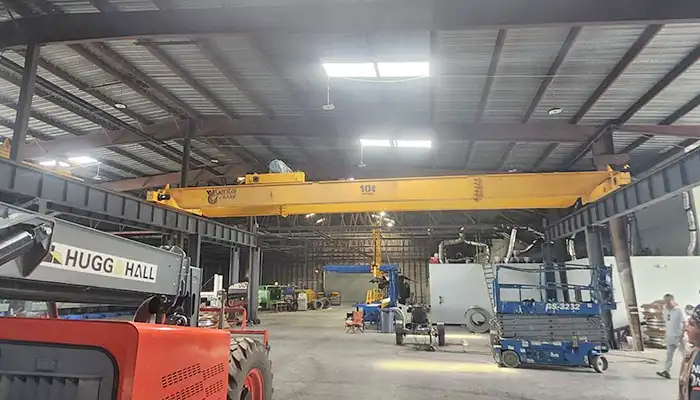
Affordable 10 ton double girder overhead crane with CD/MD hoist trolley, built for U.S. standards, ideal for construction and industrial lifting
Free consultation to Confirm Parameters & Specifications and Get
Latest Crane Price & Crane Rate.
- Types of overhead cranes : _______?
- Optional: Overhead travelling crane, goliath gantry crane,Slewing jib crane, Single girder or double girder crane,small portable crane or kbk crane, etc.
- Capacity of overhead crane: _______?
- Optional: 0.25ton, 0.5 ton, 1 ton, 2 ton, 3ton, 5 ton, 10 ton,15ton, 20ton, 25 ton, 30ton,35ton, up to 550ton, etc.
- Crane span & lifting height : _______?
- Crane travelling length : _____?
- Control of overhead crane:_______?
- Optional: pendant/ remote/cabin control
- Voltage supply of overhead crane:_____?
- Eg,: 380V50/60HZ,3Phase or others,etc.
- Application/usage of crane:_______?
- Eg,: Steel mill, ,injection mold, cement,stone, concrete,granite, general manufacturing, etc.
Just leave a message via the contact form and our hoist and crane engineer will contact you with in 24working hours.
Get In Touch
